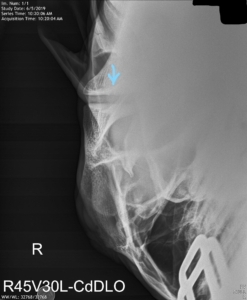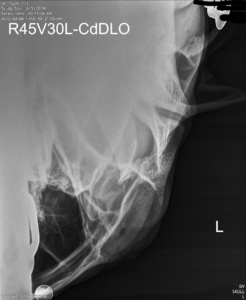June Case of the Month – Temporomandibular Joint Disease (TMD)
There are many reasons for poor performance in the horse. Pain is a very common cause, and owners and veterinarians dedicate a lot of time investigating its source in their horses. Occasionally oral discomfort can be the source. However, when dental disease, oral ulceration, and bit fit are ruled out, we investigate the temporomandibular joint (TMJ) as the possible cause. The TMJ connects the mandible (jaw) to the maxilla (skull) and can be stressed by continual and repetitive pressure from the bit.
Surprisingly, we do not often diagnose TMJ disease (TMD) in the horse. This may be because the joint physiologically is different than other joints in our horses, and it behaves differently. It may be because TMD has very ambiguous ‘poor performance’ related symptoms such as reluctance to move forward, reluctance to collect, changes in head carriage, bucking, rearing, lameness and changes in gait. Or it may be because we simply are not looking for it often enough, as proper diagnosis requires advanced imaging and other diagnostic techniques.
Recently we examined a gelding used in dressage as he was having some difficulties under saddle. The owner was concerned the source of the problem was in the mouth. We floated his teeth but the behaviour continued. Examination of his right TMJ revealed sensitivity and inflammation. The TMJ was radiographed to reveal a cystic structure in that joint. This was the first time we had seen a bone cyst in the TMJ, so we contacted an expert in the field of TMD.
Very few bone cysts have been reported in the TMJ of the horse. There have been a few cases in Europe, and a couple in North America. Dr James Carmalt, Equine Surgeon at WCVM in Saskatoon, is heading research in TMD, and developing a surgical approach for treatment of TMD. In order to help raise awareness, Dr Carmalt has started the Equine TMJ Disease Facebook page for this under-diagnosed condition.
- Right TMJ with Cyst
- Left TMJ without Cyst



